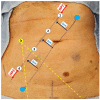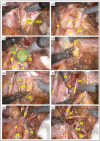Robotic Lateral Pelvic Lymph Node Dissection in Rectal Cancer: A Feasibility Study from a European Centre
- PMID: 38202097
- PMCID: PMC10779823
- DOI: 10.3390/jcm13010090
Robotic Lateral Pelvic Lymph Node Dissection in Rectal Cancer: A Feasibility Study from a European Centre
Abstract
Introduction: The role of robotic lateral pelvic lymph node dissection (LPLND) for lateral pelvic nodal disease (LPND) in rectal cancer has yet to be investigated in the Western hemisphere. This study aims to investigate the safety and feasibility of robotic LPLND by utilising a well-established totally robotic TME protocol.
Methods: We conducted a retrospective study on 17 consecutive patients who underwent robotic LPLND for LPND ± TME for rectal cancer between 2015 and 2021. A single docking totally robotic approach from the left hip with full splenic mobilisation was performed using the X/Xi da Vinci platform. All patients underwent a tri-compartmental robotic en bloc excision of LPND with preservation of the obturator nerve and pelvic nerve plexus, leaving a well-skeletonised internal iliac vessel and its branches.
Results: The median operative time was 280 min, which was 40 min longer than our standard robotic TME. The median BMI was 26, and there were no conversions. The median inpatient stay was 7 days with no Clavien-Dindo > 3 complications. One patient (6%) developed local recurrence and metastatic disease within 5 months. The proportion of histologically confirmed LPND was 41%, of which 94% were well to moderately differentiated adenocarcinoma. Median pre-operative lateral pelvic node size was significantly higher in positive nodes (14 mm vs. 8 mm (p = 0.01)). All patients had clear resection margins on histology.
Discussion: Robotic LPLND is safe and feasible with good peri-operative and short-term outcomes, with the ergonomic advantages of a robotic TME docking protocol readily transferrable in LPLND.
Keywords: lateral pelvic lymph node dissection; minimally invasive surgery; robotic colorectal; robotic rectal cancer.
Conflict of interest statement
JSK is a proctor with intuitive surgical. All other authors declare no conflict of interest.
Figures




Similar articles
-
Robotic pelvic side-wall dissection and en-bloc excision for locally advanced and recurrent rectal cancer: outcomes on feasibility and safety.ANZ J Surg. 2022 Sep;92(9):2185-2191. doi: 10.1111/ans.17757. Epub 2022 May 12. ANZ J Surg. 2022. PMID: 35555959
-
Robotic lateral pelvic lymph node dissection after chemoradiation for rectal cancer: a Western perspective.Colorectal Dis. 2020 Dec;22(12):2049-2056. doi: 10.1111/codi.15350. Epub 2020 Sep 21. Colorectal Dis. 2020. PMID: 32892473
-
Robotic and laparoscopic salvage lateral pelvic node dissection for the treatment of recurrent rectal cancer.Surg Endosc. 2023 Jun;37(6):4954-4961. doi: 10.1007/s00464-023-10000-5. Epub 2023 Apr 4. Surg Endosc. 2023. PMID: 37016084
-
Robotic versus laparoscopic total mesorectal excision with lateral lymph node dissection for advanced rectal cancer: A systematic review and meta-analysis.PLoS One. 2024 May 29;19(5):e0304031. doi: 10.1371/journal.pone.0304031. eCollection 2024. PLoS One. 2024. PMID: 38809911 Free PMC article.
-
Laparoscopic and robotic lateral lymph node dissection for rectal cancer.Surg Today. 2020 Mar;50(3):209-216. doi: 10.1007/s00595-020-01958-z. Epub 2020 Jan 27. Surg Today. 2020. PMID: 31989237 Free PMC article. Review.
Cited by
-
Onset and prognostic features of anastomotic leakage in patients undergoing radical surgery after neoadjuvant chemoradiation for rectal cancer.World J Gastrointest Surg. 2024 Dec 27;16(12):3710-3719. doi: 10.4240/wjgs.v16.i12.3710. World J Gastrointest Surg. 2024. PMID: 39734438 Free PMC article.
-
Advancement of indocyanine green fluorescence imaging technology in laparoscopic surgery for rectal cancer.World J Gastrointest Surg. 2025 Apr 27;17(4):104020. doi: 10.4240/wjgs.v17.i4.104020. World J Gastrointest Surg. 2025. PMID: 40291865 Free PMC article. Review.
-
Robotic-Assisted Colon Cancer Surgery: Faster Recovery and Less Pain Compared to Laparoscopy in a Retrospective Propensity-Matched Study.Cancers (Basel). 2025 Jan 13;17(2):243. doi: 10.3390/cancers17020243. Cancers (Basel). 2025. PMID: 39858025 Free PMC article.
-
Initial experience and results of robotic lateral pelvic lymph node dissection in locally advanced rectal cancer-a single center experience of 17 consecutive procedures.Int J Colorectal Dis. 2024 Dec 17;39(1):204. doi: 10.1007/s00384-024-04782-w. Int J Colorectal Dis. 2024. PMID: 39688615 Free PMC article.
-
Robotic Beyond Total Mesorectal Excision (bTME) for locally advanced and recurrent anorectal cancer: a systematic review.J Robot Surg. 2025 Jul 16;19(1):397. doi: 10.1007/s11701-025-02573-1. J Robot Surg. 2025. PMID: 40670732 Free PMC article. Review.
References
-
- Watanabe T., Muro K., Ajioka Y., Hashiguchi Y., Ito Y., Saito Y., Hamaguchi T., Ishida H., Ishiguro M., Ishihara S., et al. Japanese Society for Cancer of the Colon and Rectum (JSCCR) guidelines 2016 for the treatment of colorectal cancer. Int. J. Clin. Oncol. 2018;23:1–34. doi: 10.1007/s10147-017-1101-6. - DOI - PMC - PubMed
-
- Akiyoshi T., Watanabe T., Miyata S., Kotake K., Muto T., Sugihara K. Results of a Japanese nationwide multi-institutional study on lateral pelvic lymph node metastasis in low rectal cancer: Is it regional or distant disease? Ann. Surg. 2012;255:1129–1134. doi: 10.1097/SLA.0b013e3182565d9d. - DOI - PubMed
LinkOut - more resources
Full Text Sources
Research Materials

